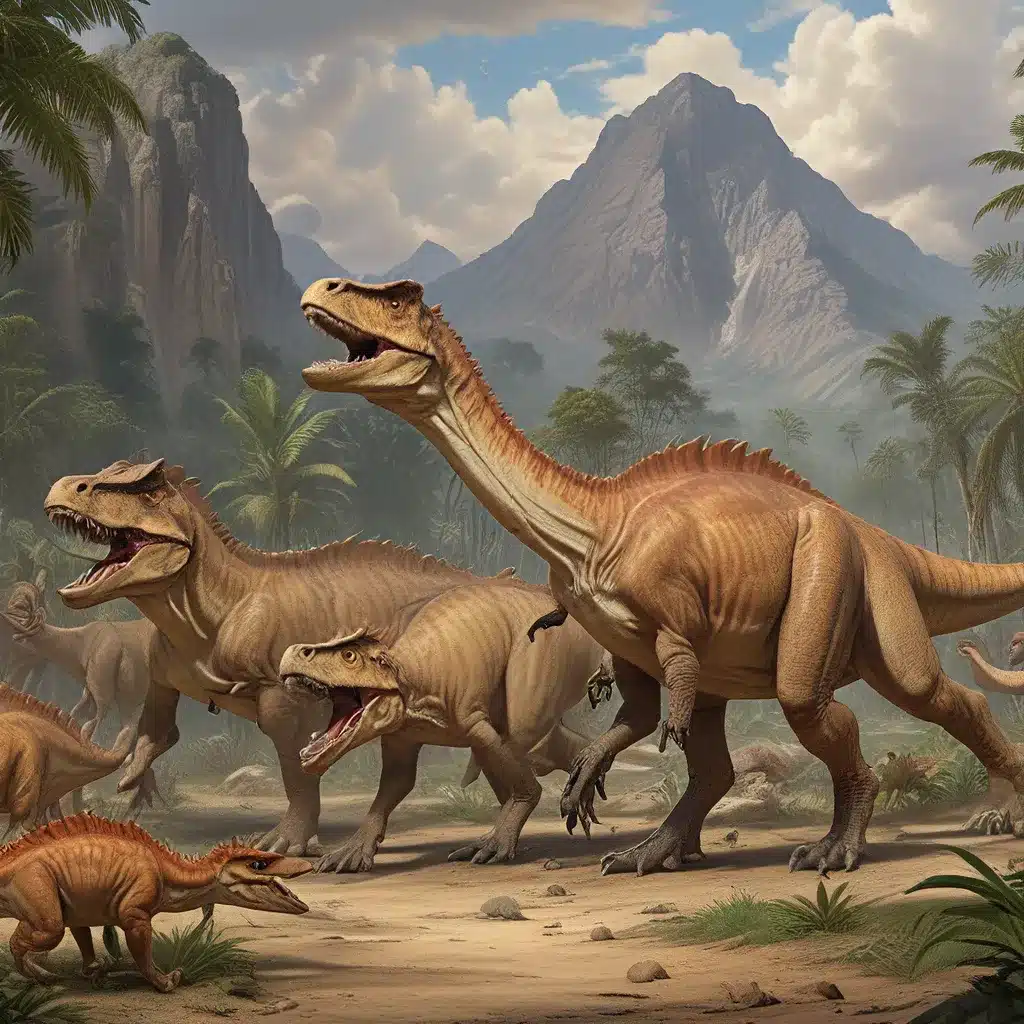
Unraveling the Ancient Lineages of Prehistoric Dominance
The dinosaur realm was a world of diverse and awe-inspiring creatures, each with their own evolutionary stories to tell. These prehistoric giants were not merely individual titans, but members of dynamic lineages that rose and fell over the course of millions of years. Tracing the intricate family trees of these Mesozoic behemoths reveals a tapestry of adaptation, competition, and the relentless march of time.
The earliest dinosaurs emerged during the Triassic period, branching off from their archosaur ancestors as part of the Dinosauria clade. These pioneering forms, such as the small, bipedal Eoraptor and the fearsome Herrerasaurus, set the stage for the explosive diversification that would follow. As the Triassic gave way to the Jurassic, the dinosaur dynasties truly came into their own, with the rise of iconic groups like the towering sauropods, the heavily-armored stegosaurs, and the agile, predatory theropods.
The Jurassic Powerhouses: Sauropods and Theropods
The sauropods, with their long necks, massive bodies, and thick, column-like legs, were the undisputed giants of the Jurassic. Genera such as Brachiosaurus, Diplodocus, and the truly colossal Argentinosaurus dominated the herbivore niche, grazing on the lush gymnosperms that thrived during this time. Their sheer size and efficient digestive systems allowed them to outcompete other herbivores, cementing their position as the ruling families of the Jurassic.
Alongside the sauropod giants, the theropods – the carnivorous branch of the dinosaur family tree – also experienced a remarkable flourishing. Tyrannosaurid and carcharodontosaurid predators like Tyrannosaurus and Giganotosaurus emerged, honing their hunting skills and becoming the apex carnivores of their respective ecosystems. Meanwhile, the maniraptoran theropods, including the ancestors of modern birds, began to diversify, experimenting with new adaptations and ecological roles.
The Jurassic Landscape: A Changing World
The Jurassic world was a dynamic and ever-evolving landscape, shaped by the interplay of climate, geography, and the rise and fall of dominant species. As the supercontinent Pangaea began to break apart, the rifting landmasses created new opportunities for the dinosaurs to spread and diversify. Distinct regional faunas emerged, with the sauropods and theropods of North America and Europe differing from their counterparts in Asia and South America.
The Jurassic also saw the rise of flowering plants, which gradually gained prominence alongside the previously dominant gymnosperms. This shift in the plant world had profound implications for the herbivorous dinosaurs, as many species adapted to exploit the new food sources, developing specialized dental batteries and other innovations to process the tougher, more nutritious vegetation.
The Cretaceous Transition: Upheaval and Resilience
The transition from the Jurassic to the Cretaceous period marked a turning point for the dinosaur dynasties. While the sauropods and theropods continued to flourish, new players emerged on the scene, such as the heavily-armored ankylosaurids, the horned ceratopsians, and the duck-billed hadrosaurids. These groups adapted to the changing environmental conditions, often developing specialized features to better exploit the evolving plant communities.
However, the Cretaceous also saw the beginnings of the events that would ultimately lead to the CretaceousPaleogene (K-T) extinction event, which would bring an end to the reign of the non-avian dinosaurs. The Deccan Traps volcanic activity in India and the Chicxulub asteroid impact in Mexico’s Yucatan Peninsula both had profound impacts on global climate and ecosystems, setting the stage for one of the most dramatic mass extinctions in Earth’s history.
Surviving the Cataclysm: The Avian Dinosaurs
While the mighty non-avian dinosaurs succumbed to the K-T extinction, one lineage managed to endure: the birds. Descended from the maniraptoran theropods, these feathered descendants of the dinosaurs were able to weather the catastrophic changes that swept the planet, thanks to their smaller size, varied diets, and ability to exploit new ecological niches.
The Mesozoic avian dinosaurs, such as the iconic Archaeopteryx, had already begun experimenting with flight and other adaptations that would prove crucial to their survival. As the non-avian dinosaurs vanished, the birds diversified rapidly, filling the void left by their extinct kin and transforming into the diverse array of species we know and appreciate today.
Unraveling the Mysteries: Cutting-Edge Discoveries
The study of dinosaurs has come a long way since the initial scientific descriptions of these ancient creatures in the 19th century. Advancements in paleontology, including the widespread application of cladistic analysis and the discovery of exceptional fossil preservations in conservation Lagerstätten, have revolutionized our understanding of dinosaur evolution, physiology, and behavior.
From the Jehol Biota of China, which has yielded a wealth of feathered dinosaur specimens, to the pioneering work of researchers like Mary Higby Schweitzer on the preservation of soft tissues, the pace of new discoveries continues to challenge and refine our knowledge of the dinosaur dynasties. As we delve deeper into the fossil record, the ancient lineages of these prehistoric titans continue to captivate and inspire, shedding light on the dynamic and interconnected world of the Mesozoic.
Conclusion: Conserving the Dinosaur Legacy
The “Dinosaur Dynasties” of the Jurassic and Cretaceous periods have left an indelible mark on our collective imagination, inspiring generations of scientists, artists, and enthusiasts. From the towering sauropods to the fearsome theropods, these prehistoric giants have become icons of the natural world, serving as vivid reminders of the wonders and fragility of life on our planet.
As we continue to unravel the mysteries of the dinosaur lineages, it is crucial that we also work to preserve the rich fossil heritage that holds the key to their stories. By supporting paleontological research, conservation efforts, and the responsible stewardship of archaeological sites, we can ensure that the legacy of the dinosaur dynasties endures, inspiring future generations to explore the wonders of our ancient past and the vital lessons it holds for the present and future.
The Lost Kingdoms is committed to celebrating the remarkable history of the dinosaurs and their place in the grand tapestry of life. Join us as we continue to explore the Mesozoic world and uncover the secrets of the ruling families that once dominated our planet.


